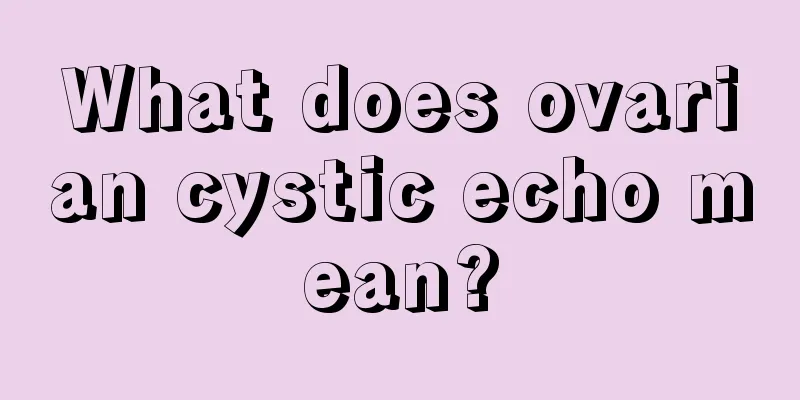What does ovarian cystic echo mean?

|
Ovarian cystic echo is a very common disease in daily life. It not only causes great harm to the patient's physical health, but also seriously affects their normal life and work. Therefore, it is particularly important to understand relevant knowledge and find scientific and effective treatment methods. When people find relevant symptoms, they need to seek medical treatment in time and choose appropriate treatment methods according to their actual situation. 1 There are two possibilities for ovarian cystic echo. One is the physiological dark area or inflammatory mass. The second is ovarian cyst. Hello, based on the above situation, it is recommended that you take anti-inflammatory drugs for a week, and then check the B-ultrasound again next month. If the cystic mass is significantly reduced, it is inflammatory and physiological. If it is present in every check-up, it is an ovarian cyst. If it is more than 4.5 cm, surgery must be performed. 2 If you are now in the ovulation period (14 days after menstruation), it may be a follicular cyst, which will disappear on its own after ovulation. Generally, small cysts on the ovaries are not a big problem. You can check the B-ultrasound again after the next menstruation to see if there is any change in the size and nature of the cyst. If the cyst increases significantly and changes in nature within a short period of time, further treatment is required. 3 Ovarian cysts with uniform echo, cysticity, and no echogenic dark areas may be follicular cysts. Generally, surgical treatment is recommended for cysts >= 6 cm, and some blood-activating and blood-stasis-removing drugs can be used for smaller cysts 4 The right ovary has a cyst, which is not big and can usually disappear on its own. You have a lot of pelvic fluid accumulation, which should be pelvic inflammatory disease. If you have abnormal menstruation, a feeling of abdominal heaviness, fever and other symptoms, it is recommended that you take anti-inflammatory treatment. 5 The cystic echo of about 3.5 cm by 3.1 cm is an ovarian cyst; the irregular liquid dark area of 3.3 cm by 1.9 cm is pelvic effusion but is within the normal range and does not require treatment. 6 In your case, it is considered a right ovarian cyst. If it is painless and grows slowly, you don't need to worry about it. If it grows quickly, you can surgically remove it. |
<<: Ovarian cysts after egg retrieval
>>: How much is the amount of implantation bleeding?
Recommend
What are the benefits of women wearing jade bracelets?
Women love to dress up and wear gold and silver w...
How can I relieve my stomach pain when my period comes?
It is easy to have abdominal pain after menstruat...
What kind of exercises are suitable for menstruation?
During menstruation, women should pay attention t...
How to exercise to tighten the vagina
For women, they can feel happy only when their va...
What can I eat to gain weight and enlarge my breasts?
As we all know, thinness is considered beautiful ...
What should women eat to delay menopause
From the perspective of women's endocrine sys...
Urine leaks like menstruation
I believe that when it comes to the situation whe...
The clitoris is there
Where is the clitoris? The clitoris is made up of...
What does Wang Jie think - Covering with a thick blanket, listening to music, counting sheep, taking melatonin, which one can really save insomnia
Recently, many people have asked me how to improv...
HandsetDetection: Data shows that the Galaxy S3 is still the most popular device
According to statistics from market research comp...
What causes bilateral nipple pain?
The nipple is an important part of the breast and...
Is 22mm of pelvic fluid serious?
Pelvic effusion reaches 22mm, most of which is ph...
Why do armpits hurt during menstruation?
During the menstrual period, women's bodies a...
What causes hair loss after childbirth?
Many female friends have experienced hair loss to...
What causes uterine cysts?
There are many reasons why women experience abdom...






![[Doctors Talk About Medicine] Warm companionship of supervisory nursing: Good medication habits for tuberculosis patients](/upload/images/67f17c4014513.webp)


